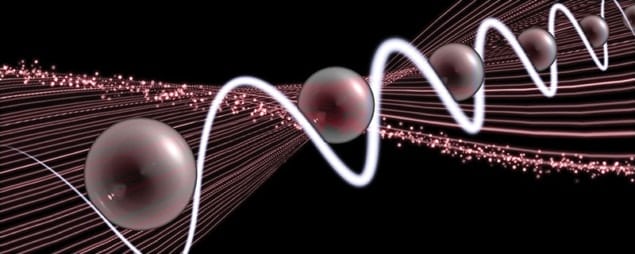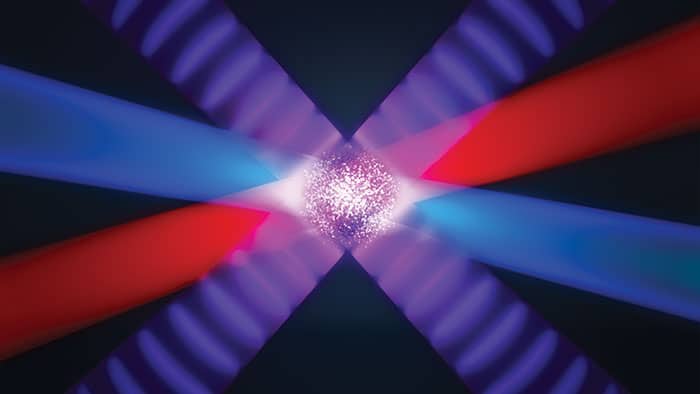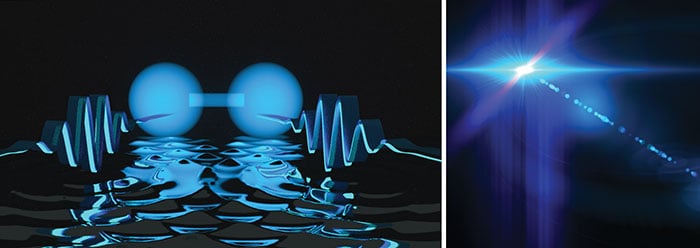Quantum computers of the future could operate via the energy transitions of excited atoms, or even from pure light, if a rapidly growing area of atomic physics continues to meet with success, writes Keith Cooper

For physicists chasing the holy grail of quantum computing, one tasty recipe is becoming increasingly widespread. Sprinkle a handful of atoms – rubidium is a popular ingredient – into a vacuum chamber. Treat with laser beams to cool the atoms to mere fractions of a degree above absolute zero. Then add a couple of photons and hey presto – you’ve created one of the basic building blocks of a quantum computer.
At least, “that’s the basic idea”, says Mark Saffman, an atomic physicist at the University of Wisconsin–Madison in the US. Central to it all are Rydberg atoms, which have a single outer valence electron that can be excited to higher quantum states. They’re the big daddies of the atomic world. Typically an atomic nucleus is femtometres in size, but in a Rydberg atom the excited valence electron can travel microns from the nucleus while still remaining bound to it, ballooning the atomic radius a billion-fold in size. With such a great reach, a Rydberg atom can interact with other nearby atoms via a powerful electric dipole moment a million times better than “ordinary” atoms. It’s this interactive power – and the ability to control it with a single, carefully chosen photon – that makes Rydberg atoms such a potent force in the world of quantum information systems.
Gateway technology
At the heart of any computer – digital or quantum – are logic gates. A quantum computer works at the atomic scale, where quantum mechanics reigns, meaning the logic gates must also be built out of atoms. A NOT gate, for example, has a single input and two states, 0 and 1, but for the gate to work it requires that the atoms not just interact, but that the interaction is controlled. The electric dipole strength of Rydberg atoms and our ability to control their excitation makes them perfect for quantum logic gates.
In 2010 Saffman and his colleagues at Wisconsin demonstrated the ability to build logic gates using two neutral rubidium atoms, complementing work conducted by a team led by Philippe Grangier at the Institut d’Optique near Paris. The quantum version of a NOT gate is the Controlled-NOT, or CNOT, gate, in which the rubidium atoms themselves are the quantum bits – or “qubits” – of information. One is labelled “control”, and the other “target”. In their ground state, which sports various hyperfine states that hold the quantum information, the atoms don’t interact – the four microns separating them might as well be an infinity. However, by exciting the control atom into the Rydberg state by firing a resonant photon at it that gets absorbed, the valence electron rises to a higher energy level, extending its reach sufficiently to permit an interaction with the target atom, “flipping” it and allowing the CNOT gate to operate. “By using the laser to excite the control atom, we can turn on the interaction and perform our logic gate, before returning the atoms to the ground state,” says Saffman.
Previous experiments had used ions to create CNOT gates, but the problem with ions is that, being charged, there is no easy way to switch their interactions off, which limits how many can be combined into a stable qubit. Neutral Rydberg atoms, however, don’t face this problem. That’s not to say that Rydberg atoms are a new development – they’ve been known about since the late 1800s. What has really spurred the development of Rydberg physics has been the advent of laser trapping and cooling, for which Steven Chu, Claude Cohen-Tannoudji and William Phillips shared the Nobel Prize for Physics in 1997. It is this ability of physicists to hold and manipulate individual atoms using light that has opened the way for Rydberg atoms to be used in exotic new applications.
Starkly shifted
Lasers can be used to create an “optical dipole trap” that can hold and cool atoms to mere microkelvin above absolute zero, or even down to nanokelvin in some cases. By criss-crossing the lasers, this method can be expanded into a 2D or 3D optical lattice. The lasers are tuned to a colour distinct from the atom’s resonant frequency, to avoid the atoms absorbing any of the photons (which would give them energy to jump out of the trap). At this point, a phenomenon known as the Stark effect comes into play, which is the shift in an atom’s energy levels in response to an electric field of alternating current, as in that produced by an electromagnetic wave. For ground-state atoms, the energy levels are shifted to a slightly lower energy. The most intense part of the laser beams, which is where they cross in the lattice, then becomes a potential well in which the atoms become trapped, because it is here that they experience the greatest shift and lose the most energy (figure 1).

Once trapped, the atoms can then be excited to the Rydberg state by firing a photon of resonant frequency at them. The trouble is, the energy of the resonant photon can jolt the atom out of the trap, and so the search has been on for “magic wavelengths” that can both trap and excite an atom at the same time. In 2015, building on nearly a decade’s worth of work by atomic physicists, a group led by physicist Trey Porto at the University of Maryland’s Joint Quantum Institute, US, found a magic frequency for rubidium atoms that simultaneously traps them in two different quantum states, which have the principal quantum numbers n = 5 and n = 18 (Phys. Rev. A 91 032518). In other words, they can be excited to a Rydberg state of 18s, where the excited electron is in the 18s orbital, while remaining in the trap. This magic wavelength corresponds to an infrared wavelength of about 1064 nm. By a sheer stroke of luck, this is the wavelength produced by a Nd:YAG laser, which most physicists use anyway because it provides some of the cheapest laser power available. That is particularly important when you want a lot of power without bankrupting your physics department.
“Really, we’ve been sneaky and picked a colour of light that traps both the Rydberg state that we’re interested in and the ground state,” says physicist Elizabeth Goldschmidt, who was one of Porto’s team members and is now based at the US Army Research Laboratory in Maryland.
Although Porto’s team excited the rubidium up to 18s, it was only a start. To get to higher quantum numbers – which results in stronger interactions across greater distances between atoms as well as extending the lifetime spent in the excited state – you need shorter and shorter magic wavelengths. Lasers that emit these shorter wavelengths are not as widely available as 1064 nm lasers and, at the highest frequencies, they can become cost-prohibitive. Nevertheless, the magic wavelengths are a huge advance for physicists such as Saffman. “He traps individual atoms and gets them to interact in gates, so he cares more about finding their magic wavelengths,” says Goldschmidt.
So far so good, but magic wavelengths and Rydberg excitation are not enough on their own to make a quantum computer. What’s missing is the quantum aspect that allows a qubit to exist in many states at once, as opposed to binary bits that can only be in one of two states. In Rydberg physics, this quantum aspect is provided through entanglement.
“The entanglement is the bit that gives you something more than you can do with a classical computer,” explains Charles Adams, a physicist with the Joint Quantum Centre at Durham University in the UK. The entanglement is produced by the interaction of the Rydberg atoms with other unexcited atoms around them. In essence, Saffman’s CNOT gate is an entanglement machine and the efficiency of the gate depends on the “fidelity” of the entanglement, which is defined as the amount of successful computations that the entangled logic gate achieves compared to the total number of attempts.
Running the blockade
When the atoms are the qubits, the photon’s role is simply to excite the atoms into their Rydberg states. However, Adams, among others, has been chasing a slightly different prize: a quantum computer made of light.
In such a device, rather than the atoms being the qubits, the photons would act as the qubits instead. Immediately there’s a potential showstopper. Photons, being massless particles, don’t interact with one another and so ordinarily cannot create logic gates. Expose them to Rydberg atoms, however, and the game changes, allowing physicists to create exotic photonic states and even “molecules” of light.
It’s all possible thanks to the cliquey nature of Rydberg atoms. Gather a close bunch of rubidium atoms (or strontium, caesium, sodium or whatever your favourite neutral atom is), cool them down and send in a photon. One of the atoms is excited to the Rydberg state and interacts with the other atoms around it, shifting their energy levels. So when a second, identical, photon is sent into this “Rydberg ensemble”, it finds that it is suddenly out of tune with their resonant frequency and cannot excite them. In essence, the Rydberg atoms put a “blockade” on the creation of other Rydberg atoms from a second photon within a volume perhaps 10 μm in diameter.
For the second photon, however, that’s good news. “It means that the second photon sees a different optical response to the medium – effectively it can see a different refractive index – so the behaviour of the medium to the second photon is very different from the first,” says Adams. As long as the two photons are of the same frequency, the rubidium cloud becomes transparent to the second photon, an effect called “electromagnetically induced transparency”. Ordinarily the second photon would race ahead, but the rubidium cloud’s refractive index is altered in such a way that the second photon stays close to the Rydberg ensemble excited by the first photon.
As the atoms excited by the first photon return to the ground state after a few microseconds, then not only can the first photon continue on its way, but the second photon is also free to form its own Rydberg ensemble, putting a blockade on the first photon. In this fashion, the two photons push and pull each other through the rubidium cloud at about 400 m/s, until they emerge together, quantum entangled and seemingly bound like a molecule.

In this situation, the photons and Rydberg atoms become strongly coupled, says Mikhail Lukin of Harvard University, US. He co-created the blockade technique in cold atoms in 2001 along with his colleagues Robin Cote, Michael Fleischhauer, Ignacio Cirac and Peter Zoller, and was also the first to use blockades to create these Rydberg-enhanced molecules of light in 2012 along with Vladan Vuletić of the Massachusetts Institute of Technology, US.
“The coupling means they essentially form a new quasi-particle called a polariton, which is part light and part atoms,” Lukin explains. The atomic half of the polariton acts as a brake for the photons, so the greater the atomic excitation, the slower the propagation velocity of the photons through the rubidium. Lukin and Vuletić are now working on repeating the experiment with more than two photons.
These photon–photon interactions are fundamentally different from how light normally acts and they open the door for using entangled photons as the circuits of quantum computers. But atomic logic gates are not out of the picture just yet, says Goldschmidt. She thinks that the optical logic gates of the interacting photons would be better applied to quantum simulations rather than quantum computing per se.
A quantum simulator, as the name suggests, simulates complex systems rather than computes them. In essence, it’s a quantum version of a computerized many-body simulation and would be designed to tackle specific problems. “In a quantum simulation you have interactions between the many bodies of your quantum system and you can thus simulate some other many-body quantum system without trying to implement code with specific gates,” says Goldschmidt.
Desktop devices
Researchers working on Rydberg physics have one main aim, regardless of whether the Rydberg atoms themselves will be the circuits of quantum information systems, or whether photons facilitated by Rydberg atoms take that role. Their goal is to push for higher-fidelity manipulation of these logic gates to increase the quality of their output and provide internal error corrections. The best way forward, envisions Lukin, is a hybrid system, whereby Rydberg atoms and photon interactions are both involved in the information processing.
“What’s interesting about our approach is that it enables us to utilize the best of both worlds,” he says. “For computing, you might want to store qubits using atoms, but to communicate between the stored qubits, you actually would like to use photons.”
Adams goes even further, speculating how quantum computers and simulators could one day become desktop machines, not by cooling their atoms to incredibly frigid temperatures, which involves large apparatus and lots of power, but by operating at room temperature. Adams and his colleagues at Durham have conducted experiments with Rydberg atoms in “hot” vapours up to 50 °C, but the problem is the Brownian motion that ensues in the warm, energetic atoms. Since photons are stored within the medium as a wave, this motion destroys the phase information, meaning that the photonic qubit cannot be retrieved. Still, if this and other challenges can be overcome, then Adams suggests it may be possible to build a quantum computer in which photons stored in virtual bubbles imposed by the Rydberg blockade process mediate an interaction that forms an optical gate. “But we’re still some way off knowing how to do this kind of integrated all-optical circuit,” he says.
Rydberg physics is not the only game in town when it comes to quantum computers. Trapped ions, superconductors, diamonds and Bose–Einstein condensates among others are competitors for the quantum crown. But Rydberg atoms have other uses too. For example, by choosing a Rydberg ensemble at a specific resonant frequency – say terahertz, or microwave – it could act as a sophisticated sensor, producing an optical output when it picks up those fields. Photon–photon interactions forced by Rydberg blockades could even lead to exotic states of light that are considered crystalline or liquid, where the interactions hold the photons together in something that might look like a lightsaber.
“Rydberg physics has grown in momentum throughout the last decade,” says Adams. “There are groups almost everywhere now doing some aspect of this.” It is remarkable what Rydberg physics could accomplish, considering the ingredients are some of the simplest things in the universe: atoms and photons.
- Journal of Physics B, from IOP Publishing – which also publishes Physics World – is currently releasing a focus issue on “Rydberg atomic physics”



